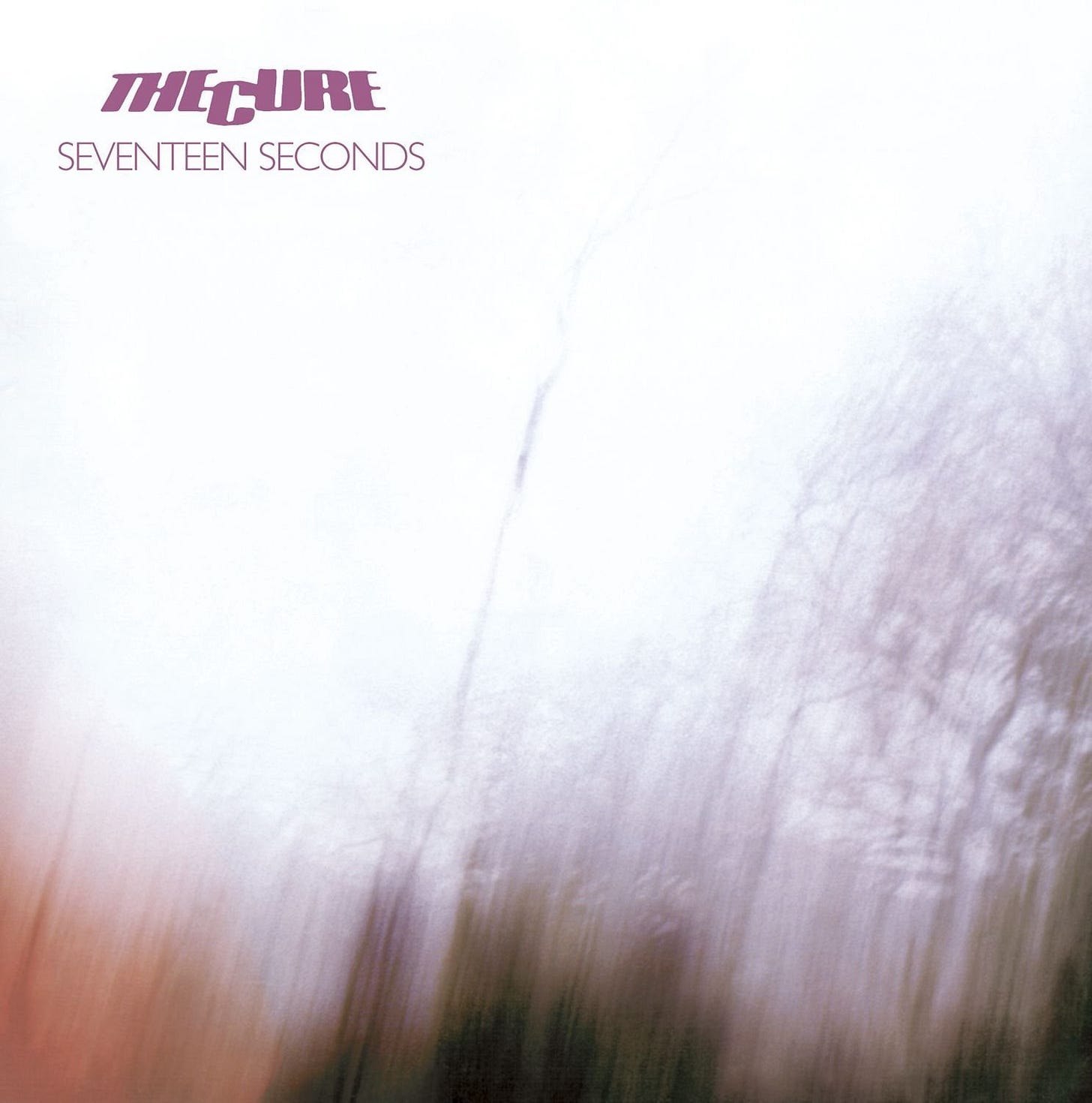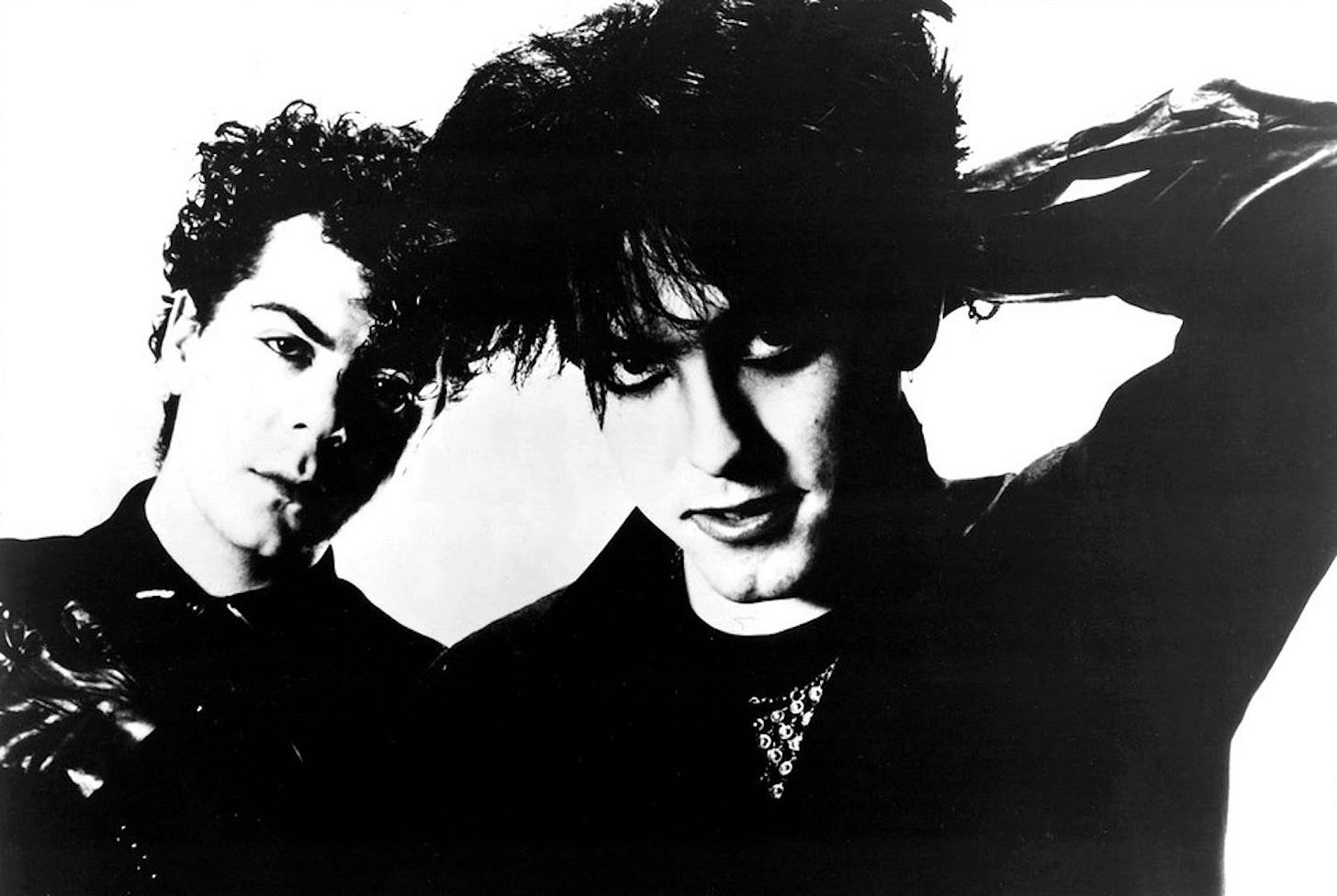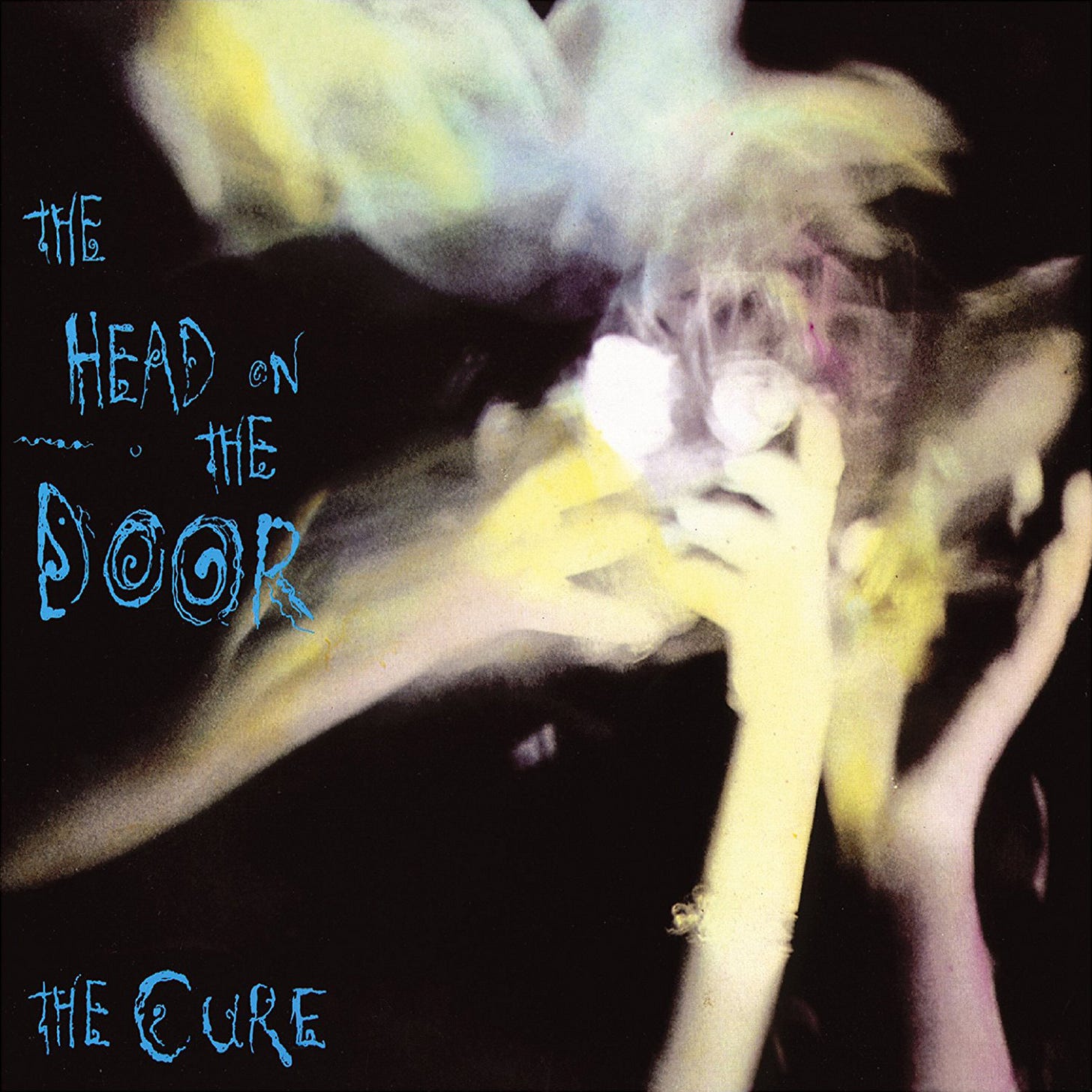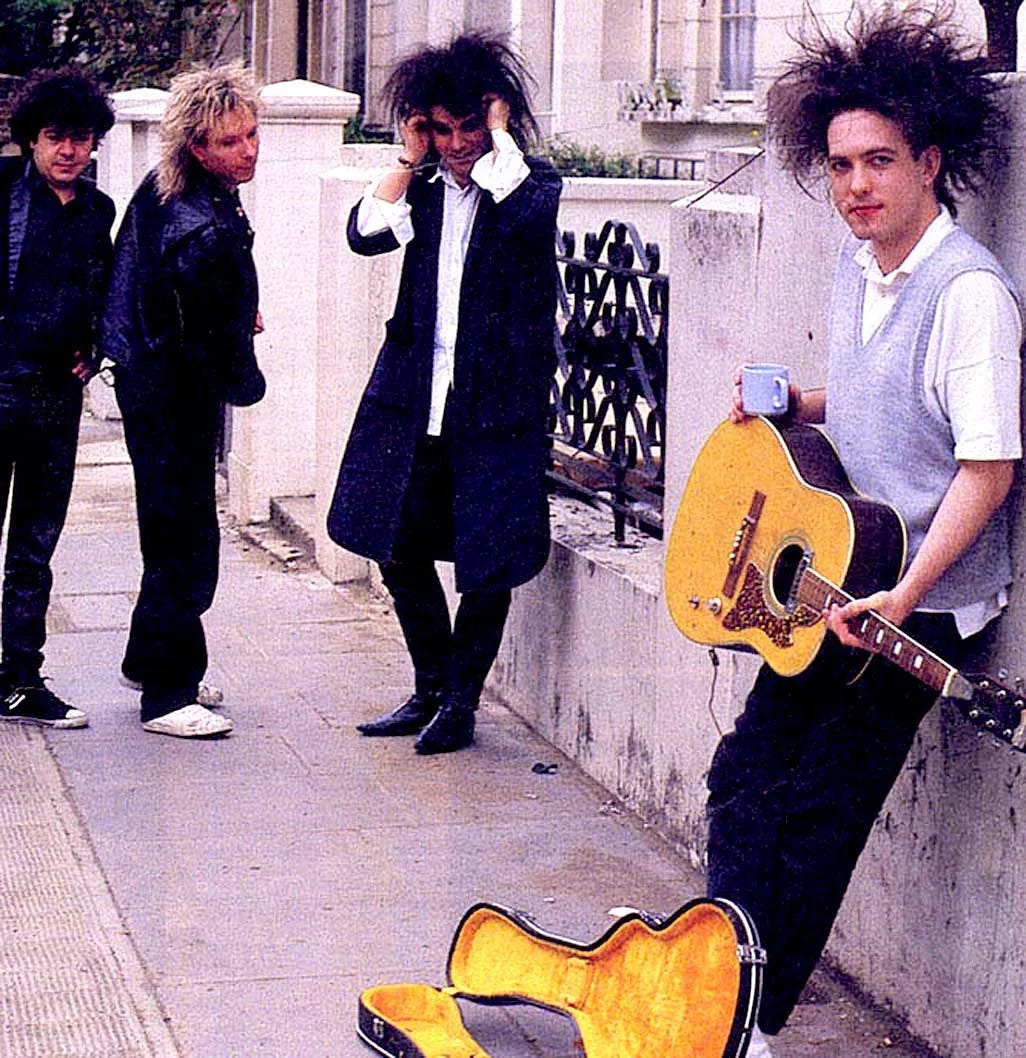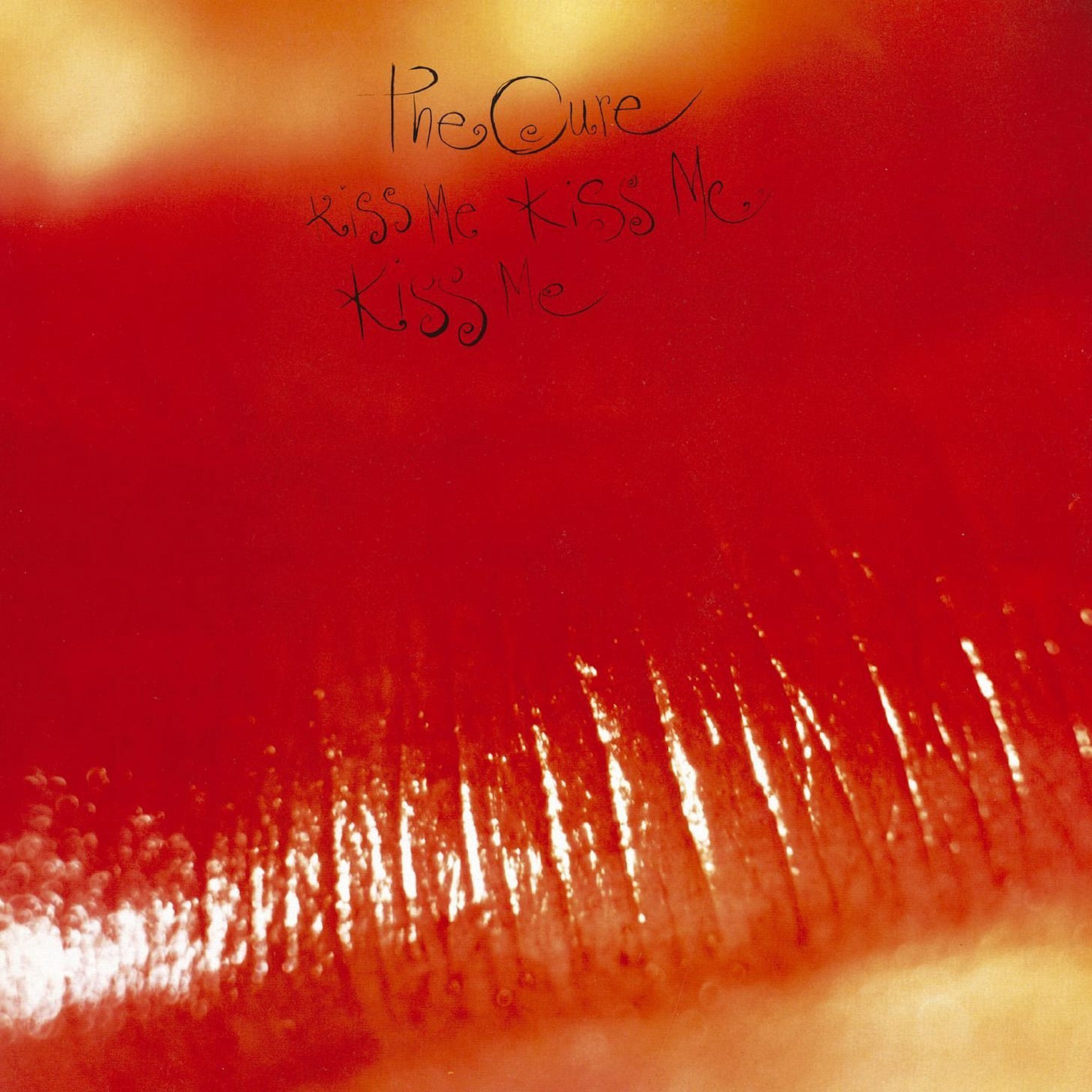THE CURE 1979-1987: A REFLECTION
A SELECT DISCOGRAPHY: Illustrated by a deep cut from each album from the first half of their UK studio LP catalogue. At the time, every single was a winner, but the album tracks were too...
It’s a seemingly controversial opinion, but I think that 1989’s Disintegration by The Cure, often heralded as their masterpiece and a beacon of excellence in a discography of unimpeachable genius - is a bit crap.
It began a dribbly, predictable downslide for a band who - up until that point - had never released a bad song - be that throwaway studio outtake, live interpretation, single B-side or ramshackle bootleg demo.
Theirs is an astonishingly consistent catalogue of quality - until Disintegration turned them into a parody of themselves, surrendering the exciting unpredictability that had made them such a great band to follow up to that point for the stylistic security of keyboard washes, floaty melodies, whiney vocals and occasional pop nuggets .
Where once they thrived on the liberty of being able to try new things and entirely shift expectation between releases, from Disintegration onwards, I would argue, that they became predictable, dull and a clichè.
Dribbly.
And I should know. I spent my mid-teens entirely obsessed by the band. They were the soundtrack to my adolescence, informing musical values and aesthetics I retain to this day. They’re a really important part of my pop personality and evolution.
I remember the disappointment I felt when Disintegration was released, and how my musical obsession was devastatingly cut off at the knees - immediately ending my ongoing interest in the band and their contemporary songs from thereon in.
The Cure had become a band I used to love.
My relationship with them had remained distant in the intervening thirty five years, until, in a spate of retro-activism, I bought tickets to see them play at the ludicrously impersonal Wembley Arena in 2022. Even in such a hollow environment, and with only half a band that I recognised, they were amazing. The new material they played was engaging and deep - I was excited by new songs from The Cure again.
It’s been two years since that show and now those songs are finally being released in the form of the long-awaited Songs from a Lost World. The first single, Alone, is released today. They played it live. It’s really good. The marketing campaign for its release has been innovative and suspenseful, complete with code-cracking websites and anonymous fly-posting in historically significant locations, such as Robert Smith’s birthplace and the first pub they ever played in. It’s cool - it’s aimed at the nerds.
What’s interesting is that The Cure have always created nerds out of their fans, somehow. It’s not often that someone has a casual interest in the band - at least, in my experience - you’re either all in or all out - so by leaning into obscurities for the Songs from a Lost World campaign, they’re addressing the hardcore fan-base directly.
Clever.
So, in order to honour the impending release of the first album of new material by The Cure in 16 years, this selective career retrospective takes a listen to what I consider to be the band’s glory years, by taking a deep cut from each album up to 1987’s Kiss Me Kiss Me Kiss Me, that I think exemplifies that period of their career as well as the more well known contemporary singles did.
To be clear - the band’s singles were all 10s - this isn’t a criticism of them. My point is simply that the album tracks were just as good - so let’s shine a light on some of the lesser known songs on what is a fantastic run of immaculate LPs.
To think they released so many great songs and albums so consistently over just eight years is astonishing. Songs From A Lost World comes after a break from new material of twice that time-span. In the UK, we were voting in the Brexit referendum eight years ago. That frustratingly futile “future” has gone by in the blink of an eye.
It’s amazing to me that they covered so much ground in that time. What a fertile period those years were.

The Cure were formed in Crawley, beneath the roar of passenger jets taking off and landing at nearby Gatwick Airport, thirty-five miles south of central London, in 1978.
The band members (at the time Robert Smith, Lol Tolhurst and Michael Dempsey) would take the train up to London as frequently as they could, to see and take part in the exciting cultural explosion that was happening in the capital at that time.
What they were witnessing helped to direct where they were going with their band - first as The Easy Cure, but then as The Cure - but even at this formative stage, Smith’s songwriting was not “normal” or conforming to “punk” expectations.
Their debut single, Killing an Arab immediately courted misbegotten controversy with people assuming it was a racist slur, when in fact, it outlined the events held within the pages of Albert Camus’s existentialist novella The Outsider.
Immediately taking a dour angle with lyricism and imagery. Smith’s sulky and bored tone of voice was equally contrary to the raging eyeballs, disgust and anger that most of the the bands of that era were presenting.
From the off, the trio were standing out as different from the rest of the post-punk scenesters of the time, who had already adopted near-identical uniforms and were cloning each other in the name of the King’s Road - something that seemed so contrary to the ethos behind the music - and something Smith et al never indulged in.
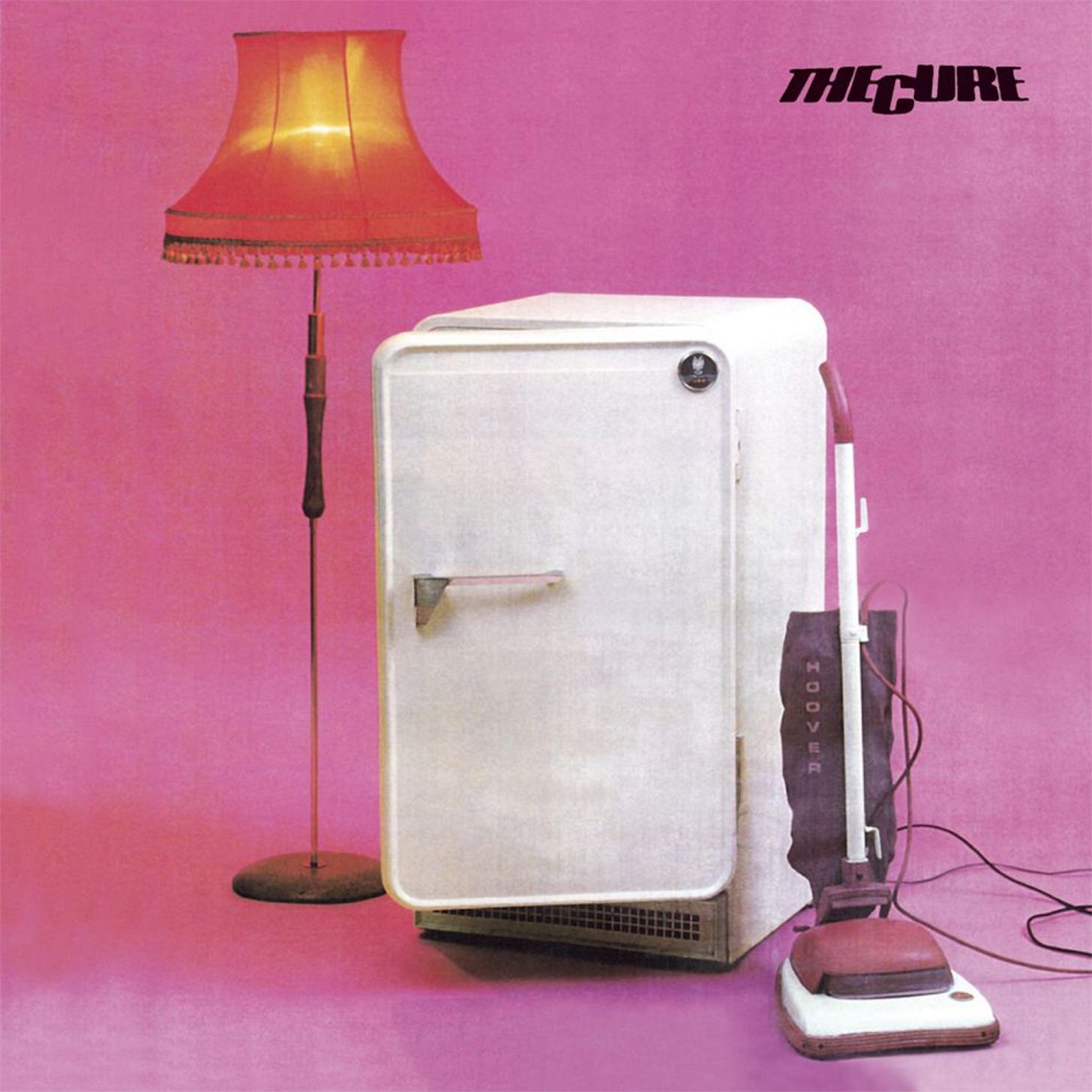
IT’S NOT YOU, THREE IMAGINARY BOYS, 1979 (FICTION)
Their first album, Three Imaginary Boys, was released the next year and was choc-full of fantastic post-punk/new-wave two minute bursts of energy. Controversially, it didn’t contain any of the band’s singles. Killing an Arab was the only release that preceded the album, which came out in May. Boys Don’t Cry followed in June and Jumping Someone Else’s Train in October.
A great run of three perfect guitar pop singles.
The album kicks off with 10.15 on a Saturday Night, which is far from conventional in its structure, or its instrumentation. Although no singles are present, innumerable tracks could have been be used as one if the band had chosen to; Grinding Halt, Object, Fire in Cairo or Three Imaginary Boys itself are more than capable of fulfilling a nation’s need for pop-tastic 45s in 1979.
However, what makes Three Imaginary Boys interesting to me is the group of songs that all sound like outtakes that make up the majority of the second side. Foxy Lady sounds nothing like the Jimi Hendrix original and may as well not be a cover, So What’s lyrics read directly from the packaging of some icing sugar, offering the opportunity to send off for an Icing Bag and three Piping Nozzles, saving one pound fifty two pence on its RRP. Meathook sees Robert take us on a trip to the local butcher’s shop for some steak.
Curious takes on domestic life that are/were different to anything else at the time.
And then there’s It’s Not You. A sister song to Object, from Side One.
Both tracks share a heavily distorted, perkily paced, no-nonsense power chord central riff, and are easily the most punked-up tracks on the album - but It’s Not You is profoundly overlooked for being as iconic as it is.
Rarely dragged out to be played live, you get the sense that Smith considers it a throwaway song when, for me at least, it’s anything but.
I think of it as The Cure’s Another Girl Another Planet - not that it defines the band in the same way as that song does for The Only Ones - but the songs share a perfect pop aesthetic that’s really fulfilling.
The performances across the board are great - the distortion on Smith’s guitar and vocals lends a real urgency to the song and the malicious tone of the lyrics has a truculent energy that isn’t found anywhere else on the LP. Dempsey’s wandering bass has a musicality that you can’t imagine Simon Gallup particularly approving of and Lol’s drums are so basic and lo-fi that they give the whole song a live, raw and unrehearsed attitude that’s really compelling.
PLAY FOR TODAY, SEVENTEEN SECONDS, 1980 (FICTION)
To think that Seventeen Seconds was released forty four years ago is astonishing. Essentially, alongside Siouxsie and the Banshees’ Kaleidoscope, Bauhaus’ In The Flat Field and Joy Division’s Unknown Pleasures, Seventeen Seconds established the cornerstones of goth as we know it - but more importantly, it set in motion The Cure’s chameleonic personality and established that the only things fans should expect from them was the unexpected.
Seventeen seconds is a huge stride on from the caustic punk pop of Three Imaginary Boys. Lol’s drumming sounds minimalist - more like a machine, Simon Gallup’s canny knack for a repetitive bass groove and Robert’s realisation that driving chords weren’t necessary to steer every song all come into play, as well as the single note, monophonic simplistic keyboard sounds.
There’s an elegant primitivism to the album - enhanced by sparsely populated tracks and even the beginnings of ambient soundscapes in the background to some of the songs.
It introduced a real depth of emotion and structure to The Cure. A Forest - one of the band’s most popular songs - has stood the test of time and was the single from the album. It still features in virtually every live set and has become something of a calling card for The Cure.
However, for my money, the track that is truly indispensable on Seventeen Seconds is Play For Today. I remember first hearing it as a teenager and immediately embracing its ear-worming central keyboard riff and enigmatic lyrics.
I loved the title too. It was nostalgic even then, referencing BBC Radio Four’s afternoon drama session.
It’s still a perfect example of The Cure’s songwriting prowess - and formed a highlight of their set when I saw them in 2022. The glee on the faces of the entire audience was apparent, as any sensitivity that the main theme of the song might contain originally, was dispelled when it turned into a terrace chant that the entire stadium woah’d along with.
It was a catalyst and an emotional moment - somehow so out of sync with the original song but so in sync with the moment. It was tingly.
The song itself deals with the communication issues, emotional expectations and domestic disappointments at the heart of a relationship, emphasising the kitchen-sink drama so often performed as a Play For Today at the time.
It was, is and always will be at the very top of The Cure’s best ones for me.
THE FUNERAL PARTY, FAITH, 1981 (FICTION)
The band would follow up Seventeen Seconds by digging deeper into the sorrow and mournful atmosphere, doubling down on the motorik drums and sweeping keys, reducing guitars and upping the reverb. In doing so they produced the most beautiful, sad and moving album of their entire discography, Faith.
Aside from first single, Primary, and the second side’s one energetic moment, Doubt, the album plods along in the most engaging way. Primary and Doubt feel like the only real links to The Cure’s past. Everything else is new. Deeper; more difficult. It’s an album that you have to give time to grow, but the rewards are immeasurable - and they stay with you forever onwards.
Side Two starts with The Funeral Party, which best exemplifies the dirgey theme for the album and the one best reflected in the super-appropriate visuals of the cover art. I can’t think of another album whose artwork represents the sounds within so well.
The Funeral Party is also the most instant of the slow songs of Faith - at least it was for me - the lyrics making sense with the funerary, haunting pace of the music:
“Two pale figures ache in silence
Timeless in the quiet ground
Side by side in age and sadnessI watched and acted wordlessly
As piece by piece you performed your story
Moving through an unknown past
Dancing at the funeral partyMemories of children's dreams
Lie lifeless
Fading lifeless
Hand in hand with fear and shadows
Crying at the funeral partyI heard a song and turned away
As piece by piece you performed your story
Noiselessly across the floor
Dancing at the funeral party”
It leaves you hanging, wondering what Robert has seen and where he has seen it. It is at once exposing, enigmatic, mysterious, secretive and misty.
Nothing has sounded like it before or since.
The band would release a non-album track as a second single, Charlotte Sometimes, which went on to be the low key anthem of every live set, a beautiful Secret Garden era ghost story dream-scape.
Faith may have been The Cure at their best. At least, for me.
A STRANGE DAY, PORNOGRAPHY, 1982 (FICTION)
From the intense sadness and loss of Faith, the band lurched to the tribal torment of Pornography. Still dealing with depression and being fundamentally reflective of Robert Smith’s mental state at the time, the album focuses on another side of despondency - if Faith was melancholic, Pornography was hallucinogenic rage.
From the start, the band are taking no prisoners. Lol uniquely creates memorable riffs and hooks on the drums, as they pound and slam at the front of the mix. Guitars are no longer concerned with melody; they are sound-tracking a maelstrom; discordant, violent, frightened.
Has the first line of an album ever summed up its mood and intent as well as One Hundred Years’ opening gambit?
I doubt it:
“It doesn’t matter if we all die
Ambition in the back of a black car…”
Pornography is exclusively powerful and intense. Nothing else in their catalogue is as incessantly dense and relentless. It’s no surprise that the band collapsed in a hideous mess of acid and alcohol at the end of the album’s cycle. Lol and Robert would be left alone, wondering how to proceed in the absence of Simon Gallup, who’d had enough of the depressive chaos.
At least for a couple of years.
The one small shot towards light on the album occurs on the second song on Side Two. A Strange Day could have been as powerful a single as The Hanging Garden was. The motorik beats of Faith return, but this time, they are heavy, distorted and urgent, slammed on toms instead of their spacious conveyance on the previous album.
Robert takes us on suicidal walk along a beach, walking away into the tides. The incredible sadness of the lyrics is somehow lifted by the lighter touch of the instrumentation compared to the rest of the album; winding lead lines, a more melodic approach to the vocal lines and the drama of the lyrics come together as more of a rapture than a descent:
“My head falls back and the walls crash down
And the sky and the impossible explode
Held for one moment I remember a song
An impression of sound
And then everything is gone forever”
It’s really beautiful.
THE UPSTAIRS ROOM, JAPANESE WHISPERS, 1983 (FICTION)
If there was ever such a dramatic stylistic switcheroo between albums as there was between Pornography and Japanese Whispers (a compilation of the three 1983 singles and their B-Sides), then show me where it occurs.
Because from where I stand, there’s not been such a huge about-turn that still manages to deliver brilliant songs anywhere else, at least in my record collection.
Just play the final track from the previous album - Pornography’s cacophonous title track - and follow it with the next song the band released, the deliberately chart-bound synth-pop of Let’s Go To Bed.
Now try to convince me that it’s not the soundtrack to a some kind of brave and wonderful musically creative schizophrenia.
Smith has stated that he was so sick of the depressive and moody music the band were making that he wanted to do completely the opposite. Create something cheerful. Fiction records thought it was career suicide. Even Robert thought they’d lose all the fans they’d gained so far, but such was his frustration and need for change he did it anyway.
Japanese Whispers collects Let’s Go To Bed, The Walk and The Lovecats together on one album, alongside their five B-sides. It doesn’t feel like a compilation unless you’ve got all the 45s - each of which grew their fan-base exponentially, especially in the US, where Robert says their audience went from psychotic goths to people with shiny white teeth.
The Cure had, bizarrely, garnered a predominantly teenage girl audience.
They were bonafide pop stars.
The Upstairs Room was one of the additional tracks on The Walk 12” single and US-only Mini LP. It is as upbeat, addictive and well structured as any of the singles and could go toe to toe with any release thus far in terms of the subtleties of its songwriting.
It’s a different beast to what’s come before though - the nagging synth leads and chiming melodies are a distinct change from Faith and Pornography. This is full on synth-pop in the vein of New Order or even, maybe, Depeche Mode.
The lighthearted tune that bops away so happily masks lyrics that contradict that jollity; a sign of Smith’s integrity - it might sound like pop, but there’s much more going on beneath the nonchalant tune than that:
“Today I feel the grey
Pulse in my head
I turn off the lights and crawl into bed
I try to think of sunshineMy body goes wet
With the first crash of thunder…”
So even though it sounds happy enough, scratching the scab reveals the same old pus that haunted Smith’s psyche throughout the 80s.
BANANFISHBONES, THE TOP, 1984 (FICTION)
By the time The Top was released in 1984, Smith had tired of the pop-ness he had created and once again conveyed his dissatisfaction with a pendulum swing away from expectation.
This time, it swung eastwards for an exotic album of dissonant caterwahling created by an all-new lineup amassed around Robert and Lol.
Lead single The Caterpillar did well, but it was in no way a true stylistic taster for the rest of the LP; songs like Give Me It, Shake Dog Shake and Piggy In The Mirror brought a new level of psychedlia, discordance and din to proceedings. There’s more experimentation with the instruments too - indian strings and squwarking saxophones mix with Andy Anderson’s elegant beats to create yet another stylistic shift away from what’s come before.
The one constant through all these different styles and moods is Robert Smith’s vocals - even when the music is crazily out there, his voice grounds it and unifies it as being uniquely The Cure. It’s how they always managed to pull it off.
The songs on The Top would form the basis for 1984’s Concert live album, proving that even in that environment, the raucous din of the new songs could work and, amazingly, sit happily beside the pop nuggets, miserable maudlings or primitive guitar pop of the band’s varied discography.
Bananafishbones is the perfect example of The Top’s fairytale psychedelia. At the time, Smith was coming off a shift with the Banshees and also on the heels of a side-project with that band’s bass player, Steve Severin - The Glove. Both distractions inform the songwriting on The Top and on Bananafishbones, in particular.
It’s crazy. Mad harmonica, pumping organ, funky bass - it all muddles together behind Smith’s rambling vocals - which at first appear to have no melody associated with them at all - sounding more like a uniqely Smithsonian take on rapping - until the chorus crashes in and somehow you realise the tune’s there and it’s a gnawing exposition that stays in your head for hours, underpinned by the anticipation of the chorus.
It seems like a lawless three minutes at first, and then you uncover the genius behind it and you realise that, yet again, nothing is as it seems.
It’s the perfect example of the nonsense/LSD derived lyrical devices Smith was employing at the time, that seem so out there at first, until repeated plays bring a familiarity that turns them into addictive nuggets of the juiciest alternative goth pop.
This period in time saw The Cure becoming really well known, with plenty of TV appearances, interviews and photo shoots occurring on the band’s promotional rounds.
The Top was, pretty much, the prologue for the Smash Hits Salad Days that were just around the corner…
SIX DIFFERENT WAYS, THE HEAD ON THE DOOR, 1985 (FICTION)
It was a toss up between Six Different Ways and Push. Both songs easily sell the quirky goth pop of The Head On The Door just as well as Inbetween Days, Close To Me or A Night Like This do.
Tim Pope’s videos came into their own at this point; whether that was the black light swoops of Inbetween Days or the infamous drowning wardrobe of Close To Me, the band was suddenly proven to be artfully visual and the soaring popularity of MTV really exposed them to a huge potential audience.
I ended up choosing Six Different Ways because it meant more to me at the time. I remember having it on my Walkman and loving the weird kilter of the song and the ambiguity of the lyrics, which were enhanced when you heard a live version of the song and Smith’s comedic American accent being employed for a line or two, mid-song.
The Head On The Door was my album. It hit at the right time as an introduction to the band. I was familiar beforehand, I remember The Caterpillar being in the charts, but it wasn’t until The Head On The Door that I became a real fan. It’s a fantastic LP, full of wall-to-wall bangers. It’s dark without being moody; the eastern psychedelia of The Top has been tamed and manipulated into western anthems. Every one of them, uplifting, hooky as fuck, and really well produced.
Perhaps that’s why Six Different Ways stands out; it’s less obvious than some of the other songs. It has the ditty riffs that all of the songs on the LP have - simple little single finger keyboard identities - but, like Close To Me, it’s less conventional than the others.
And yet again, a deeper centre is obscured by the pop veneer. This time it seems to be concerned with split personalities…
“This is stranger than I thought
Six different ways inside my heart
And everyone I'll keep tonight
Six different ways go deep insideSix sides to every lie I say
It's that American voice again
’It was never quite like this before
Not one of you is the same’.”
The song manages to add itself to the chorus of voices inside your own head for a time afterwards. A multitude of weirdness singing to itself unendingly.
HOW BEAUTIFUL YOU ARE, KISS ME KISS ME KISS ME, 1987 (FICTION)
An unprecedented four singles were released to promote Kiss Me Kiss Me Kiss Me.
The mental jazzy, horn-led WTF of Why Can’t I Be You?, which addressed all the idiocy and adoration of the Robert Smith clones that followed the band around the world preceded the album.
The winsome balladery of Catch was released almost simultaneously with the double LP. Star track of the album - which has since become immortalised as one of their greatest songs, Just Like Heaven, followed in the autumn.
Then the forgettable Hot Hot Hot - perhaps their first miss of a single - was released early in 1988.
That one album - albeit one with eighteen tracks on it - could sustain four singles is amazing. That every one of those eighteen songs has significant merit, even if they’re not all singles, even moreso.
One song stands out to me as really summing up the vibe of the album. It was recorded in France, it has a warm, Mediterranean feeling to it, somehow.
How Beautiful You Are is exactly that.
It’s the story of a love-struck pair walking the streets of Paris - presumably Robert, who would wed lifelong partner Mary Poole the following summer - and the reaction of the people they meet at the beauty of her visage.
Or that’s how it seems on the surface.
Actually, despite covering that ground, it deals more with the resentment between the two and how they see the same event from totally different perspectives. There’s a vulnerability to the lyrics in the hope of one side and the disdain of the other. It ends up making for awkward listening, because there’s no happy ending, just an honest portrayal of spousal disappointment.
It’s the juxtaposition of the rolling bass and drums, the lilting melody with the harmonica and violin accompaniament - instrumentally feeling related to Just Like Heaven - and the sour pettiness of the lyrical journey that makes it so typically compelling.
“You want to know why I hate you?
Well I'll try and explainYou remember that day in Paris
When we wandered through the rain
And promised to each other
That we'd always think the same
And dreamed that dream
To be two souls as oneAnd in the road before us
Stood a weary grayish man
Who held a child upon his back
A small boy by the hand
The three of them were dressed in rags
And thinner than air
And all six eyes stared fixedly on youThe father's eyes said "Beautiful!
How beautiful you are!"
The boy's eyes said
"How beautiful!
She shimmers like a star!"
The child's eyes uttered nothing
But a mute and utter joy
And filled my heart with shame for us
At the way we areI turned to look at you
To read my thought upon your face
And gazed so deep into your eyes
So beautiful and strange
Until you spoke
And showed me understanding is a dream
"I hate these people staring
Make them go away from me!"And this is why I hate you
And how I understand
That no-one ever knows or loves another
Or loves another.”
And we’re left hanging.
That we find ourselves now, in real-life, nearly forty years later, to find Robert and Mary still happily married, suggests that though their relationship may have been the inspiration, there must have been artistic license taken with the lyrical journey.
The band would go on to create pop anthems in Friday I’m In Love, Pictures Of You, Lovesong and Lullaby, but to my ears they would never come close to the unstoppable ascent they experienced between 1979 and 1987.
I’m excited to hear the new material. It’s a different band now. The songs don’t seem as straightforward as they used to be. May be that’s a good thing, because from what we know so far, Songs From A Lost World will be intensely personal, harrowing and adventurous.
I can’t wait.




